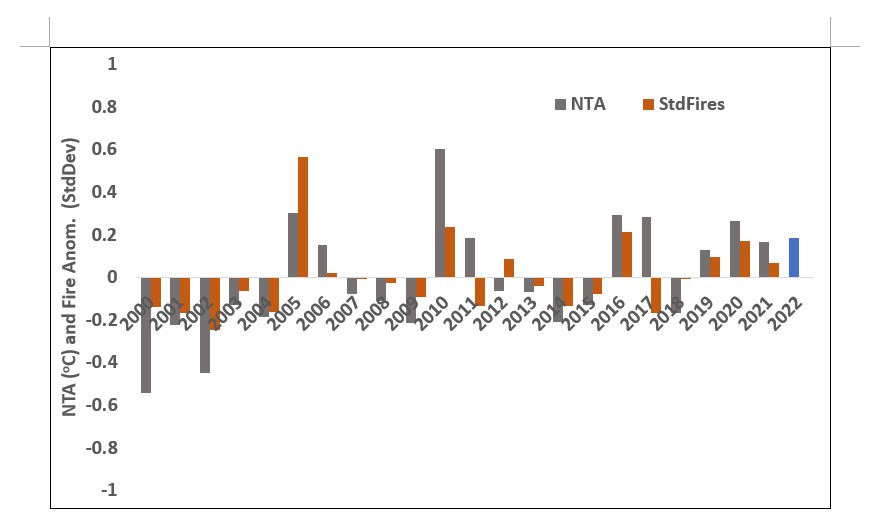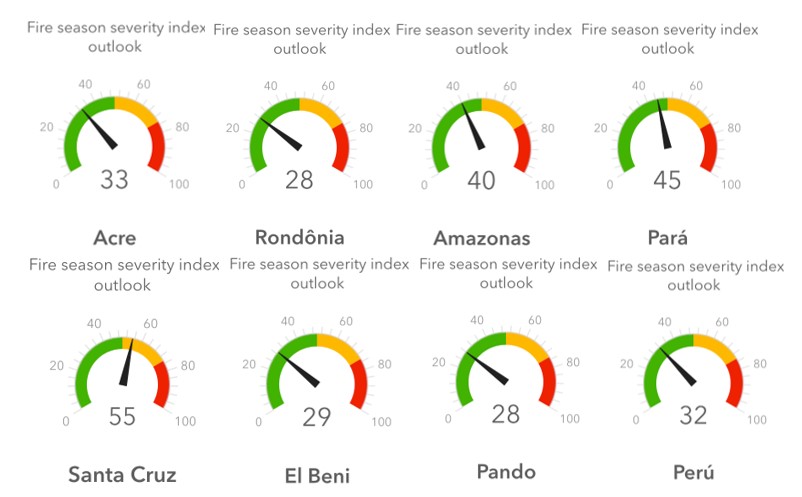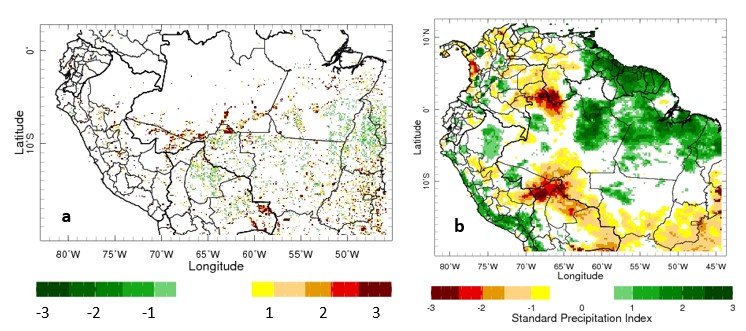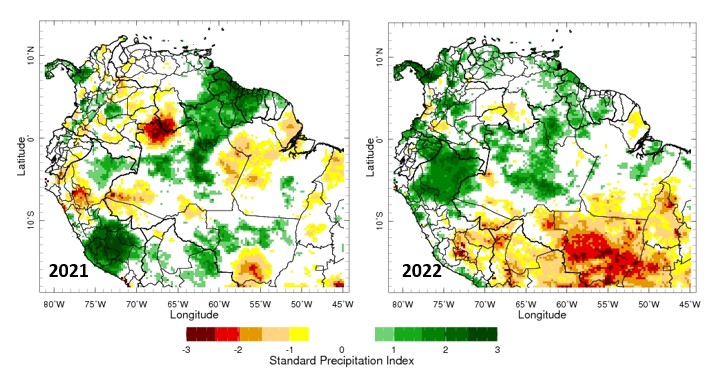Fires in the Amazon are the result of human activities that (usually) begin with slash and burn practices to clear the land for the introduction of agro-pastoral activities. For most part, fires occur over non-forest landscapes but can escape to standing forest edges and burn the understory.
Drivers of fire ignition during the dry season depends on factors such as land use practices, market demands, existence and enforcement of environmental laws and the prevalent climate. Assuming that the anthropogenic drivers are similar from year to year, unintended fire spread depends on whether the dry season is unusually dry or wet and predicting how intense the fire season will be is essential for prevention planning. Fire activity as a function of climate can be determined based on the 20 plus years of continued active fires measurements from satellite and climate variables available from observations and seasonal climate forecasts from General Circulation Models.
Fires in 2022
The seasonal fire forecast presented below follows a statistical model (Fernandes et al., 2011) that uses sea surface temperature (SST) forecast from early as March to predict July-September (JAS) fire season anomalies. The forecast is updated monthly through June and the closer the forecast is from the July-September fire season, the more robust is the outlook. Anomalously warm SSTs in the north tropical Atlantic (NTA) shift patterns of precipitation northward reducing moisture inflow into the Amazon and drought follows. Thus, it expected that a warmer NTA will translate into a more active fire season whereas a cooler NTA will result in milder (below average) fire activity (Fig. 1).
The NTA index is then used to predict JAS fire anomalies in southern and western Amazon. June forecast of the July-September (JAS) north tropical Atlantic index indicates warmer than average NTA in JAS 2022 (Fig.1) which is expected to result in a mildly active fire season predicted for western Amazon in JAS. The light pink shades in Fig. 2 indicate slightly above average activity being the predominant pattern of the 2022 forecast. Gaps in the map represent areas with no fires or with poor relationship to the NTA index.

Fig. 1. July- September (JAS) North Tropical Atlantic (NTA) sea surface temperature index (previous years’ forecast) and observed standardized fire anomalies over a domain that includes the state of Acre in Brazil and the department of Ucayali in Peru. The blue bar corresponds to current NTA forecast for the July-September 2022 season released in June.

Figure 2. July-September 2022 fire season forecast (June initialization). https://firecast.cast.uark.edu/
The statistical fire forecast model by Chen et al. (2011), shows similar results pointing to near normal fire activity predicted for the dry season as seen in Fig. 3, except for Santa Cruz in Bolívia where the latest forecast points to an above normal fire season.

Fig. 3. Fire severity outlook for Amazon in JAS 2022.
It’s important to keep in mind that the climate determines only part of the variability of the fire season. In the absence of human activities, fires would be inexistent in the Amazon rainforest biome even in dry years, while a concentrated effort to burn will likely result in more fires than usual in years with normal precipitation. Nonetheless, fire prediction based on seasonal climate forecast can provide an advanced look of the background climate condition that may favor (droughts) or inhibit (rainy) widespread fires.
Fires in 2021
Similar to our current 2022 forecast, the 2021 fire forecast pointed to a mildly active fire season in the Amazon southern and western sector.

Figure 4. July-September 2021 (a) standardized fire anomalies and (b) the Standardized Precipitation Index (SPI).
The north tropical Atlantic index forecasted in June 2021 indicated the potential for average or slightly below average precipitation during July-September. The observed precipitation pattern shown in Fig. 4b as Standardized Precipitation Index (SPI), describes drought conditions in southwestern Amazon (such as the Brazilian states of Acre and southern Amazonas) where anomalously active fire occurrence (Fig. 4a) was also observed. But the overall precipitation pattern in southern Amazon describes normal (marked as white in Fig. 4b) to above-normal precipitation (shaded in green in Fig. 4b), which helped tamper fire activity in northern Mato Grosso, Tocantins and southern Pará (shaded green in Fig. 4a).
SERVIR-Amazonia is working at various fronts to improve the robustness of seasonal fire forecast as well as visualization tools that will allow interactive mapping. In addition, meetings are being planned to inform stakeholders and potentially allow for early preventive measures in the region.
Climate conditions leading up to the dry seasons of 2022 and 2021
The predicted near to slightly above normal fire season of JAS 2022 describes a similar outlook as that of JAS 2021, when the models pointed to mild droughts and a mildly active fire season observed specially in the southwestern Brazilian Amazon.
However, the climatic condition leading up to the dry season are distinct. The 3-month SPI of June 2021 (corresponding to conditions from April to June) indicated a mild drought in the western Amazon (Fig. 5a), which persisted through JAS (Fig. 4b). In contrast, the June 2022 SPI shows anomalously positive precipitation (Fig. 5b) in most of the Amazon, except for the southern fringes including Madre de Dios in Peru, northern Bolivia and the Brazilian states of Acre and Rondonia, which could accelerate vegetation water stress and lead to favorable conditions for burning early in the JAS fire season.

Fig. 5. 3-month Standardized Precipitation Index for Jun 2021 and Jun 2022.


